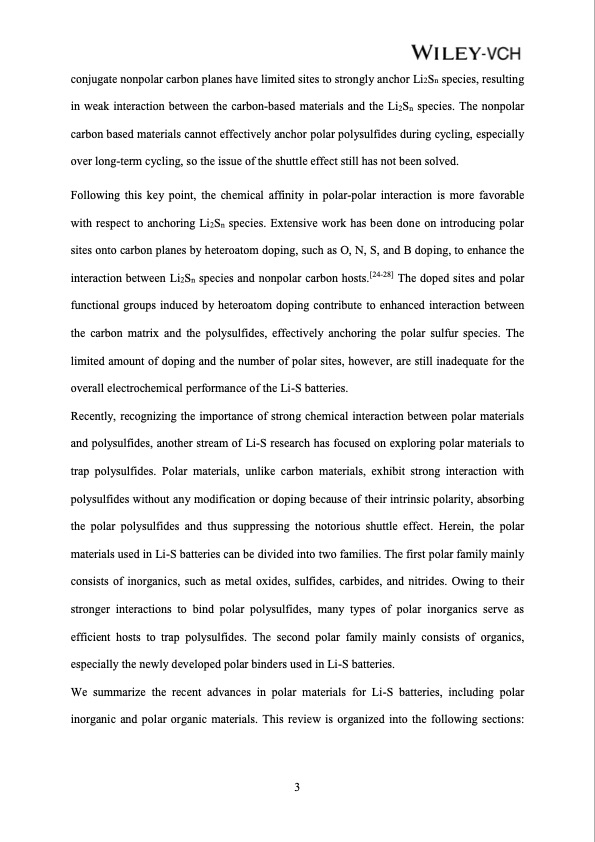
PDF Publication Title:
Text from PDF Page: 005
conjugate nonpolar carbon planes have limited sites to strongly anchor Li2Sn species, resulting in weak interaction between the carbon-based materials and the Li2Sn species. The nonpolar carbon based materials cannot effectively anchor polar polysulfides during cycling, especially over long-term cycling, so the issue of the shuttle effect still has not been solved. Following this key point, the chemical affinity in polar-polar interaction is more favorable with respect to anchoring Li2Sn species. Extensive work has been done on introducing polar sites onto carbon planes by heteroatom doping, such as O, N, S, and B doping, to enhance the interaction between Li2Sn species and nonpolar carbon hosts.[24-28] The doped sites and polar functional groups induced by heteroatom doping contribute to enhanced interaction between the carbon matrix and the polysulfides, effectively anchoring the polar sulfur species. The limited amount of doping and the number of polar sites, however, are still inadequate for the overall electrochemical performance of the Li-S batteries. Recently, recognizing the importance of strong chemical interaction between polar materials and polysulfides, another stream of Li-S research has focused on exploring polar materials to trap polysulfides. Polar materials, unlike carbon materials, exhibit strong interaction with polysulfides without any modification or doping because of their intrinsic polarity, absorbing the polar polysulfides and thus suppressing the notorious shuttle effect. Herein, the polar materials used in Li-S batteries can be divided into two families. The first polar family mainly consists of inorganics, such as metal oxides, sulfides, carbides, and nitrides. Owing to their stronger interactions to bind polar polysulfides, many types of polar inorganics serve as efficient hosts to trap polysulfides. The second polar family mainly consists of organics, especially the newly developed polar binders used in Li-S batteries. We summarize the recent advances in polar materials for Li-S batteries, including polar inorganic and polar organic materials. This review is organized into the following sections: 3PDF Image | Advances in Polar Materials for Lithium-Sulfur Batteries

PDF Search Title:
Advances in Polar Materials for Lithium-Sulfur BatteriesOriginal File Name Searched:
212718644.pdfDIY PDF Search: Google It | Yahoo | Bing
Sulfur Deposition on Carbon Nanofibers using Supercritical CO2 Sulfur Deposition on Carbon Nanofibers using Supercritical CO2. Gamma sulfur also known as mother of pearl sulfur and nacreous sulfur... More Info
CO2 Organic Rankine Cycle Experimenter Platform The supercritical CO2 phase change system is both a heat pump and organic rankine cycle which can be used for those purposes and as a supercritical extractor for advanced subcritical and supercritical extraction technology. Uses include producing nanoparticles, precious metal CO2 extraction, lithium battery recycling, and other applications... More Info
| CONTACT TEL: 608-238-6001 Email: greg@infinityturbine.com | RSS | AMP |